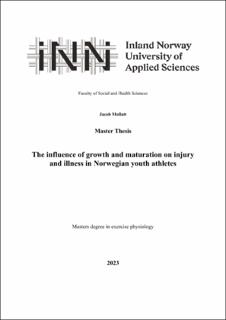| dc.description.abstract | Background
Factors related to pubertal growth and maturation in adolescence have received increasing attention over the last decades. In contrast to other studies, this study includes athletes of both genders, and from both team- and individual sports.
Method
303 youth athletes were prospectively monitored for growth, maturation and self-reported health problems for 13 weeks. Generalised Poisson regression models were used to model growth rate and maturation on health problem variables collected through weekly distribution of the Oslo Sports Trauma Research Questionnaire on Health Problems.
Results
The relationship between maturity status and severity score was non-linear in boys (p < 0.001) and in girls (p < 0.001). The relationships with severity score of substantial health problems was non-linear in boys (p < 0.001) and non-linear in girls (p < 0.001). Peak estimated severity scores, duration of health problems and full time-loss were observed between 86.8 and 92.1 % Percent of Adult Height in boys, and above 97.8 % in girls. The relationships with maturity status and duration of health problems were non-linear in boys (p = 0.003) and in girls (p < 0.001). The relationships with growth rate and severity score in boys was linear and positive (p < 0.001), and non-linear in girls (p < 0.001). Girls with growth rates above 7.2cm/year reported higher severity score (p < 0.001), longer duration (p < 0.0001), higher full time-loss (p = 0.0001) and total time-loss (p < 0.001) compared to those with growth rates under 7.2cm/year. Boys with growth rates above 7.2.cm/year reported higher severity score (p < 0.001), longer duration (p < 0.001), more full time-loss (p < 0.001), partial time-loss (p = 0.0002), and total time-loss (p < 0.0001) compared to those with growth rates under 7.2cm/year.
Conclusion
Maturity status and higher growth rate can be related to severity, duration, and type of self-reported health problems in boys and in girls, but studies of longer duration, a more evenly distributed sample and subsequent statistical measures is needed to conclude further around the details of these relationships. | |
